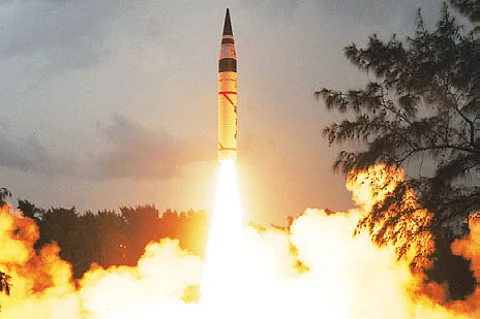

India on Monday openly declared its 5,000-km range Agni-V as an Inter-Continental Ballistic Missile (ICBM), a rocket science that is a proud possession of a select group of nations, including the US, Russia, France and China.
India’s Defence Research and Development Organisation (DRDO) chief Avinash Chander said here that the Agni-V, with its second successful test on Sunday, will now go into productionisation, following which further four or five tests would be carried out. It will be ready for induction in two years.
“Agni-V has demonstrated the capability and the range of 5,000-5,500 km and the categorisation of such missiles is ICBMs. Why should we be diffident about our strength and capability when Agni-V is capable to meet these ranges and go trans-continental. There is no doubt on that point. I have no hesitation to call Agni-V an ICBM,” Chander said.
At a press conference here to introduce the first-ever three-day Engineers Conclave being hosted by DRDO in Delhi from Tuesday, Chander was asked about the shift in the categorisation of Agni-V from its first successful test in April, 2012 when it was described as a Long Range Ballistic Missile (LRBM). “After this successful test in the canisterised form, we are going in for productionisation of Agni-V. All India’s future missiles will be canisterised, ” he said.
He said that DRDO can increase the range of the Agni-series missiles to beyond 10,000 km in about two-and-half years from now in view of technologies it has mastered with Agni-IV and Agni-V.
Chander also felt that at present, based on the threat perceptions and need, the Agni-V’s range was adequate for India, a position he had held in April 2012 too when the first successful launch of the missile was achieved.
He noted that the DRDO was working at achieving a Circle of Error Probability (CEP) or target striking accuracy of about 100 metres for Agni-V and about 10-15 metres CEP for manoeuvrable missiles.
To a question on India’s first indigenous nuclear-powered submarine, Arihant, which is expected to go out to for sea and weapons trials soon, Chander said the vessel would complete its full complement of tests of its on-board systems and weapons in about a year.
Also read: